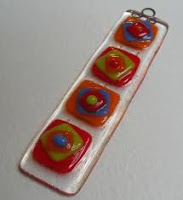"Every time you fire a previously fired piece you need to slow down."
This is not accurate. If you have not changed anything significant, the annealing does not need to be extended. The clearest example is a fire polish. Nothing has been added. The physics and chemistry of the piece have not changed. If only confetti or a thin frit/powder layer is added, nothing significant for scheduling has been added. As nothing significant has changes the annealing used in the previous firing can be used again.
Of course, you do need to slow the ramp up rates on the second firing. This is because you are firing a single thicker piece. On the first firing, the pieces are individual and can withstand slightly faster rates. But on third and subsequent firings, if nothing significant has been changed, there is no need to slow rates further.
There is a post which describes this further.
"When adding more thickness more time is needed."
This is the occasion when the annealing soak needs to be extended. Placing a full sheet of clear glass on the bottom, or less usually, the top, and taken to a full fuse, requires slower ramp rates. The annealing time for a full fuse can be taken directly from the annealing tables for thick slabs.
The fusing profile for any additional items has a strong affect on the length of the annealing soak. If the glass is now of uneven thicknesses, and greater care in assigning ramp rates is needed. The profile for the piece also determines the amount of additional annealing time required. A sharp tack of a single additional layer will require annealing as for 2.5 times the total height of the piece at the start or the firing. A rounded tack will need two times and a contour fuse will require 1.5 times. A full fuse can be carried out for the new total height of the piece without any multiplying factors.
The general approach to multiple firings is that unless there are changes to the thickness or profile of the glass, no changes in annealing time is required.



